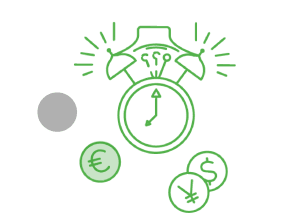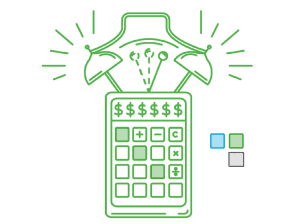From this article, you will learn:
- what activities the taxpayer will be able to perform in a VAT warehouse;
- when the entity using the VAT warehouse procedure will have to pay the VAT due.
Polish VAT regulations are to be extended to include the non-customs warehousing procedure (the so-called "VAT warehouse"). The VAT warehouse is to introduce a significant simplification for taxpayers in the settlement and collection of VAT on transactions related to international trade in goods.
Who and under what circumstances will be able to apply the VAT warehouse procedure?
Thanks to the new Polish regulations, entrepreneurs making transactions related to international trade in goods will be able to enter goods into the so-called VAT warehouse.
The entry of goods into a VAT warehouse will be taxed at a 0% rate.
This means that the moment of actual taxation of the supply of goods will be postponed by the legislator until the completion of the VAT warehouse procedure.
Goods for the VAT warehouse procedure will be reported by the buyer (VAT warehouse manager).
What activities will the taxpayer be able to perform in a VAT warehouse?
The VAT warehouse procedure will allow entrepreneurs and foreign investors to:
- enter goods into the warehouse,
- store goods,
- provide services directly related to stored goods,
- remove goods from the warehouse.
Examples of services directly related to stored goods include sorting, reloading, packing, keeping goods in the right condition or temperature, and preserving goods.
Learn more about related services
What conditions must a company meet to apply the VAT warehouse procedure?
Businesses will be able to use the VAT warehouse procedure provided that the following conditions are met:
1. The taxpayer will obtain a permit to operate a VAT warehouse
A VAT warehouse will be allowed to be operated only by an entity that obtains a permit. It will be issued by the head of the customs and tax office after meeting certain conditions and will be valid only at the place of the customs warehouse.
The permit to operate a VAT warehouse will be issued for an indefinite period.
2. The company will keep records in the VAT warehouse
The entity keeping the VAT warehouse will be obliged to keep, in electronic form, the appropriate quantitative records of goods entered, stored and removed from the VAT warehouse.
3. The entity will obtain permission to use the VAT warehouse procedure for specific goods
The VAT warehouse procedure can be used after obtaining a permit, which depends on the fulfillment of certain conditions. The permit will be issued by the head of the customs and tax office at the taxpayer's request.
The authorization to use the VAT warehouse procedure will be issued for a limited period (initially proposed period is 18 months).
4. The taxpayer will subject the goods to the VAT warehouse procedure
Goods subjected to the VAT warehouse procedure will be considered by Polish regulations as goods declared and entered into the VAT warehouse procedure.
Excise goods, goods delivered at the retail sale stage and consumable goods (including those intended for consumption) included in the VAT warehouse will not be subjected to the VAT warehouse procedure.
Goods placed under the procedure cannot be an object of delivery in a warehouse. This means that the entrepreneur will not be able to further sell goods before the completion of the VAT warehouse procedure.
The entity will be able to declare the goods for the VAT warehouse procedure by submitting a declaration (notification) in electronic form to the head of the customs and tax office.
What conditions must the taxpayer meet to apply the 0% rate?
The supply of goods covered by the VAT warehouse procedure will be subject to taxation at the 0% rate only if all of the following conditions are met:
- the taxpayer will issue an invoice documenting this delivery using KSeF – the national e-invoice system (using structured invoices) and mark the legal basis of the applied rate of 0% on the invoice (i.e. "supply of goods subjected to the VAT warehouse procedure"),
- the taxpayer will enter the goods into the VAT warehouse,
- the taxpayer, before the expiry of the deadline for submitting a tax return for a given settlement period, will receive from the buyer a document confirming the inclusion of goods under the VAT warehouse procedure.
When will an entity using the VAT warehouse procedure have to pay the VAT due?
Completion of the VAT warehouse procedure will take place, as a rule, as a result of the taxpayer's notification of the end of the VAT warehouse procedure and removal of the goods from the warehouse, and will of course result in the obligation to pay the VAT due.
The VAT paid will, as a rule, constitute input tax for the taxpayer and will be subject to deduction in the JPK_VAT declaration.
An alternative solution will be to settle the tax due and input tax in the JPK_VAT declaration after submitting the security.
Will the entering of goods into a VAT warehouse be beneficial for entrepreneurs?
The solution proposed by the new regulations may turn out to be beneficial for those entrepreneurs who purchase goods in Poland, but know in advance that they will be destined for another country (e.g. in a situation where goods are only stored in Poland or services are provided on them).
When purchasing goods, the entrepreneur, by entering them into a VAT warehouse, will not have to settle input VAT in Poland and wait for a VAT refund (which would involve freezing funds for some time).
On the other hand, it will be beneficial for suppliers of goods to apply the 0% rate.
In the next few months, we should learn more details of the new regulations - then it will be completely clear for whom VAT warehouses may be an interesting option for arranging supply chains in Poland. To be always up to date - we encourage you to subscribe to our newsletter.
If you have any questions or need to discuss the topic, we strongly encourage you to contact our expert, Przemysław POWIERZA.





